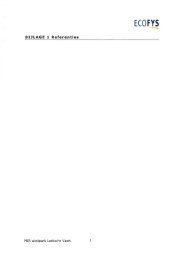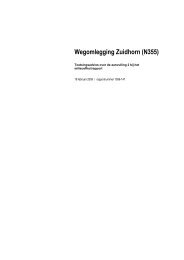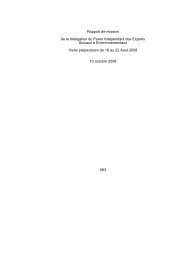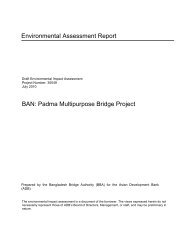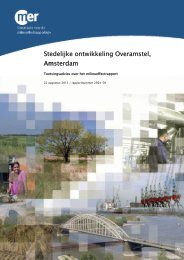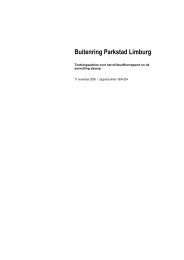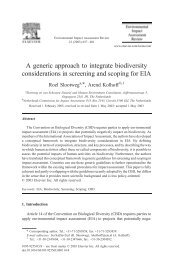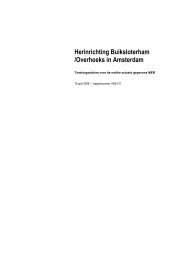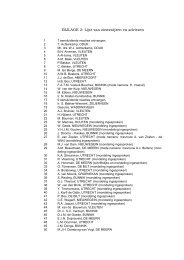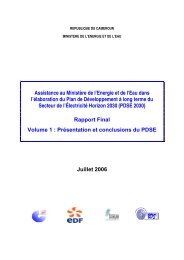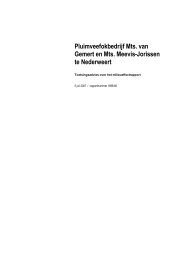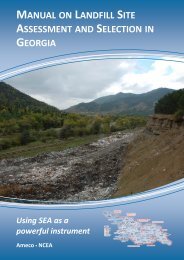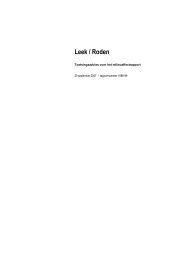Scoping Advice for the Dutch IWRM Support Programme Rwanda
Scoping Advice for the Dutch IWRM Support Programme Rwanda
Scoping Advice for the Dutch IWRM Support Programme Rwanda
You also want an ePaper? Increase the reach of your titles
YUMPU automatically turns print PDFs into web optimized ePapers that Google loves.
Management of <strong>the</strong> SEASince, as explained above, several planning questions still need to be answered, it is not possibleto provide very detailed management in<strong>for</strong>mation <strong>for</strong> this SEA. In principle, <strong>the</strong> NCEA proposes <strong>the</strong>following set up:Proposed management set up <strong>for</strong> SEA <strong>for</strong> catchment plansPlan ownerexpected: CatchmentTo be defined by Master PlanCommitteeSEA owner Lead agency To be determined: plan owner or RWRDSEA Oversight REMA Ministerial Order on SEA still to bedevelopedSEA Funding EKN <strong>Programme</strong> and/or local A funding mechanism <strong>for</strong> SEA may beconsidered under existing EIA modalities 43Obviously, <strong>the</strong> relevant actors mentioned in this table will need to agree on <strong>the</strong>ir respective rolesand responsibilities. When <strong>the</strong> time comes, <strong>the</strong>se details can be fur<strong>the</strong>r refined and defined. If sorequired, <strong>the</strong> NCEA is available <strong>for</strong> fur<strong>the</strong>r guidance on <strong>the</strong>se issues.For REMA, this set of SEAs <strong>for</strong> catchment plans would provide a good opportunity to gainexperience in its role as responsible party <strong>for</strong> SEA oversight in <strong>Rwanda</strong>. If required, NCEA would beavailable to support REMA in <strong>the</strong> <strong>for</strong>m of technical assistance or coaching using <strong>the</strong>se concreteSEAs as hands-on learning cases.In conclusion: some examples from practiseAn SEA at catchment level can have two <strong>for</strong>mats:- The SEA pro-actively identifies development opportunities and constraints, including linkedstakeholders, and in<strong>for</strong>ms <strong>the</strong> planning process. The SEA can describe <strong>the</strong> present andexpected future status of ecosystem service provision under an autonomous developmentscenario (do nothing) and define limits of acceptable change, thus setting <strong>the</strong> boundaries <strong>for</strong>catchment planning.- The SEA re-actively assesses <strong>the</strong> consequences of planned catchment development on <strong>the</strong>ecosystem services of <strong>the</strong> catchment area and its stakeholders, and identifies alternatives,mitigation or compensation measures when consequences are unacceptable.Below two flowcharts of <strong>the</strong> above mentioned <strong>for</strong>mats that were developed <strong>for</strong> <strong>the</strong> irrigation anddrainage sector of <strong>the</strong> World Bank 44 , but which can be generalised <strong>for</strong> <strong>IWRM</strong> purposes.43REMA/UNDP - General Guidelines and Procedures <strong>for</strong> SEA, June 2011, page 1544 Abdel-Dayem S., J. Hoevenaars, P. P. Mollinga, W. Scheumann, R. Slootweg, F. van Steenbergen (2004). Reclaiming Drainage.Toward an Integrated Approach. IBRD Agriculture & Rural Development Department, Report No. 1., and Slootweg, R., J.Hoevenaars & S. Abdel-Dayem (2007). Drainframe as a tool <strong>for</strong> integrated strategic environmental assessment: lessons frompractice. Irrigation and Drainage Management 56, S191-S203.41



